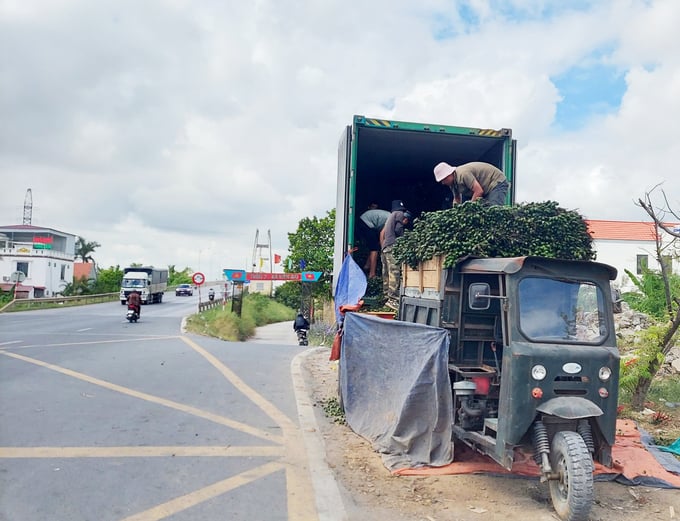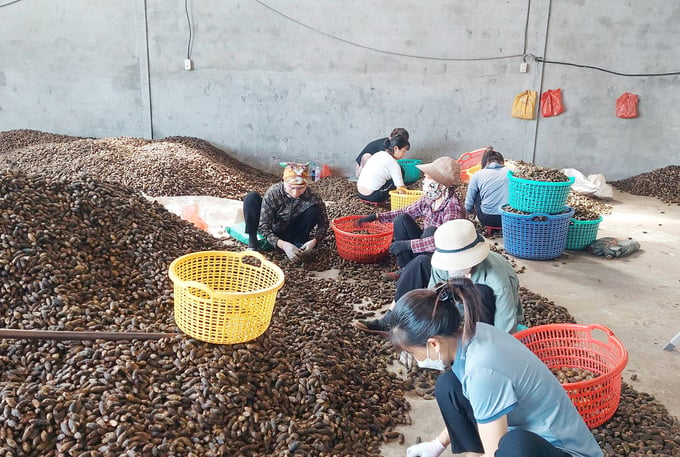December 1, 2025 | 18:54 GMT +7
December 1, 2025 | 18:54 GMT +7
Hotline: 0913.378.918
December 1, 2025 | 18:54 GMT +7
Hotline: 0913.378.918
Just a month ago, closely-fruited areca gardens were seen as gold mines, yielding record-breaking profits for growers as prices reached a historic high of up to 100,000 VND per kilogram. Each areca palm generates millions of dong.
However, those golden days seem far behind as the price of betel nuts has plummeted by nearly half, and exports to China have ground to a complete halt. Freeze storage facilities at Hai Phong port and wholesale purchasing centers are now overflowing with unsold stock, leaving betel nut traders anxious about the future.

At its peak, the price of imported fresh betel nuts hovered around 50,000–60,000 VND per kilogram, with domestic nuts fetching an even higher rate. Photo: Dinh Muoi.
Mr. Hoang Van Doan, the owner of a betel nut roasting facility in Village 8, Cao Nhan Commune, shared that he has never seen a year where prices soared to such levels, reaching 80,000 VND per kilogram for fresh betel nuts, including the stems—four times last year's price.
At its peak, the price of imported fresh betel nuts hovered around 50,000–60,000 VND per kilogram, with domestic nuts fetching an even higher rate. After processing, Vietnamese dried betel nuts were valued at 500,000 VND per kilogram, while imported nuts from Thailand and Myanmar were priced around 350,000 VND per kilogram.
Following this galloping rise, a sudden halt from Chinese buyers a month ago has led to a massive backlog of shipping containers stuck at Hai Phong port, leaving traders in a precarious position. "With prices dropping sharply from 80,000 VND to 45,000 VND per kilogram for fresh betel nuts due to the Chinese cancellations, some traders fear that prices may continue to fall, making exports uncertain," Doan explained.
In an interview with Vietnam Agriculture Newspaper, Mr. Hoang Van Tien, Deputy Chairman of the Cao Nhan Commune People's Committee, clarified that the Chinese market for areca nuts remains stable and demand is high. However, export difficulties persist as a result of the tightened control measures at border checkpoints.
Areca almonds are classified as a medicinal commodity. Recently, China has increased its regulation and inspection of this item, resulting in a halt in exports. "This is not the first time our community has encountered this problem," Mr. Tien stated.
As per Mr. Tien, the residents of Cao Nhan have a long history of purchasing and exporting areca nuts, with some locals even earning a fortune. Nevertheless, the exportation of areca seeds has been a difficult endeavor. Only a handful of years in the past two decades have experienced a zenith in prices, with the remainder being unpredictable and volatile.

Residents of Cao Nhan have been cultivating areca nuts and exporting them to China since 1988, primarily for the production of areca nut confectionery and desiccated areca nuts. Photo: Dinh Muoi.
The principal "vulnerable point" is the market access. The primary product of the community, dried areca nuts, is still not officially recognized as an export agricultural commodity. Prices are wholly dependent upon Chinese traders. Vietnamese merchants are left without products if they fail to meet quality standards or demand decreases.
Frequently, thousands of cars transporting dried areca nuts from Cao Nhan have become "stuck" at the Lang Son border entrance and, this year, at Hai Phong port. It is necessary for merchants to rent storage facilities, wait for days, or even discard moldy, spoiled areca almonds when they are unable to sell. Numerous areca nut processing facilities have closed as a result of persistent setbacks, leaving residents at a loss.
The road to exporting dried-out areca nuts is precipitous and fraught with uncertainty. To guarantee sustainable development and consistent income, residents must identify solutions that enhance product quality, diversify markets, and reduce their reliance on Chinese traders.
The primary product, dehydrated areca nuts, is not regarded as a major export commodity, although areca nut cultivation, purchase, and processing have generated substantial income. Prices are contingent upon merchants, who incur losses when demand declines or requirements are not satisfied.
Residents of Cao Nhan have been cultivating areca nuts and exporting them to China since 1988, primarily for the production of areca nut confectionery and desiccated areca nuts. This is a well-known fact. Prices continue to fluctuate although they have operated for more than two decades. Successful years in the areca nut commerce industry are scarce, according to local residents.
Additionally, it is imperative to prioritize a systematic investment in the trade community that is accompanied by supportive policies. Despite being acknowledged as a traditional areca nut cultivation and processing village since 2007, there is still no dedicated management body, and production stages frequently occur in a fragmented manner, lacking strong connections. This results in price pressures as processors become more reliant on Chinese traders for the collection and transportation of desiccated areca nuts.
“If China stops buying, Vietnam nearly has to shut down operations. Whatever price they set, we have to buy accordingly. Moreover, exported areca nuts must meet standards for size and quality according to their requirements, or else the goods will be returned,” a trader shared.
Translated by Linh Linh

(VAN) The signing of a protocol between Viet Nam and China on the export of fresh jackfruit represents a significant milestone in agricultural trade cooperation between the two countries.

(VAN) On November 27, the Ninh Binh Department of Agriculture and Environment and the Institute for Green Growth Research organized a training course on greenhouse gas inventory for businesses.

(VAN) China’s cooking oil is suddenly flooding into India. It all comes down to a soybean surplus that Beijing doesn’t quite know what to do with.

(VAN) An Giang promotes supply-demand connections, standardizes quality and builds value chains, creating a foundation for sustainable bird’s nest development and aiming to expand exports.
/2025/11/24/5339-4-nongnghiep-075331.jpg)
(VAN) Recently, the conference on 'Sustainable Fisheries Linkage Chain - Tilapia for Export' took place in Tien Hai commune, Hung Yen province.
/2025/11/21/4309-2-153400_128.jpg)
(VAN) Green and low-emission rice is paving the way for Vietnamese rice to enter high-end markets, marking the beginning of a transformation journey toward greening and elevating the national rice brand.

(VAN) ‘Right to Win’ outlines a national action plan that shapes a new vision for Viet Nam’s agriculture in an era of renewal and global integration.